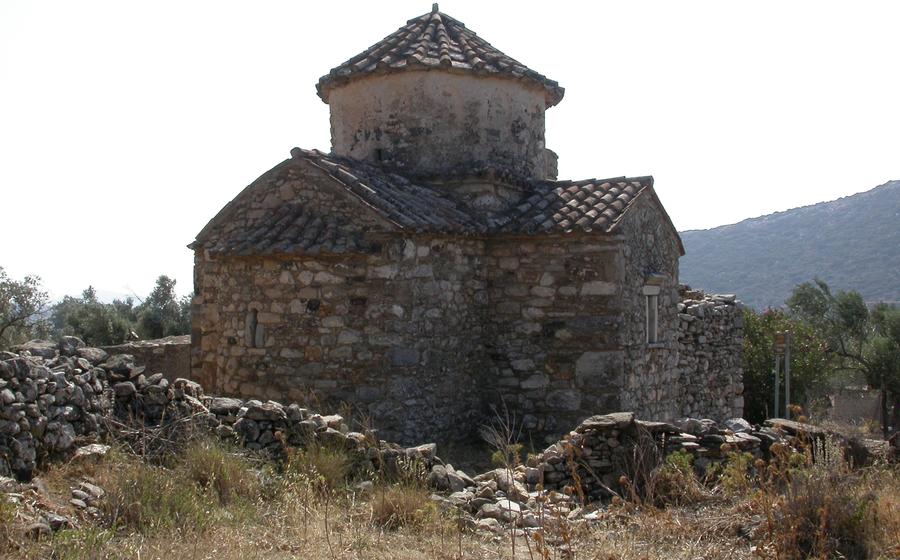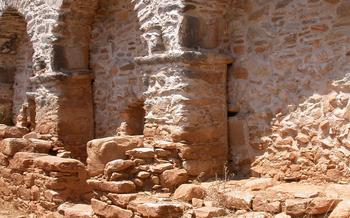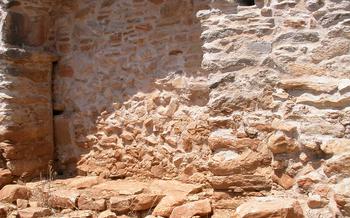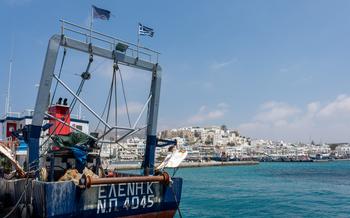
Panagia Drosiani Monastery
- Panagia Drosiani Monastery: A Timeless Sanctuary
- Location: A Picturesque Setting
- Historical Significance: A Journey Through Time
- Exquisite Frescoes: A Testament to Artistic Mastery
- Spiritual Sanctuary: A Place of Pilgrimage
- Visiting the Monastery: Practical Information
- Unveiling the Monastery's Secrets: Guided Tours
- Exploring the Surrounding Area: Beyond the Monastery
- Indulging in Local Delights: Culinary Experiences
- Capturing the Essence of Naxos: Photography Tips
- Social Media Moments: Sharing Your Experience
- Preserving the Legacy: Conservation Efforts
- Events and Festivals: Celebrating Tradition
- Insider Tip: Discovering Hidden Gems
Panagia Drosiani Monastery: A Timeless Sanctuary
Nestled amidst the picturesque landscapes of Naxos Island, the Panagia Drosiani Monastery stands as a testament to the enduring legacy of Byzantine architecture and religious devotion. Its origins can be traced back to the 6th century AD, during the reign of Emperor Justinian I. Built atop an ancient pagan temple dedicated to Dionysus, the monastery has undergone several transformations and renovations throughout its illustrious history.
The most significant changes occurred during the Venetian rule in the 13th century, when the monastery was fortified and expanded. During the Ottoman occupation, it served as a refuge for persecuted Orthodox Christians and was miraculously spared from destruction. In the 19th century, the monastery underwent a comprehensive restoration, restoring it to its former glory. Today, Panagia Drosiani Monastery remains an active religious center and a popular pilgrimage site, attracting visitors from around the world.
Location: A Picturesque Setting
Nestled on the captivating island of Naxos, Panagia Drosiani Monastery seamlessly blends into the island's rich tapestry of history and natural splendor. The monastery's idyllic location, just a short distance from the charming village of Moni, offers visitors a tranquil retreat while remaining within easy reach of the island's vibrant attractions.
Reaching the monastery is a breeze, with convenient access by car or bus. For those seeking a more immersive experience, a leisurely walk through the picturesque countryside provides an opportunity to soak in the beauty of the surrounding landscape. As you approach the monastery, the breathtaking panoramic views from its hilltop perch will leave you in awe. The azure waters of the Aegean Sea, the lush greenery of the Naxian countryside, and the distant silhouettes of neighboring islands create a picture-perfect backdrop for this architectural gem.
Historical Significance: A Journey Through Time
The Panagia Drosiani Monastery stands as a testament to the rich history of Naxos, having witnessed the rise and fall of civilizations over the centuries. Its roots can be traced back to the 6th century AD, during the Byzantine Empire, when it was initially constructed as a small chapel. During this time, the monastery served as a spiritual and religious center for the local Byzantine community.
As the centuries passed, the monastery underwent several transformations and expansions. In the 13th century, under Venetian rule, the monastery was significantly enlarged and fortified, reflecting the influence of Venetian architecture. The Venetians added defensive structures, such as a moat and a drawbridge, to protect the monastery from potential attacks.
During the Ottoman occupation of Greece, the Panagia Drosiani Monastery faced challenges and adversity. Despite the oppressive rule of the Ottomans, the monastery managed to maintain its religious significance and continued to serve as a place of worship for the Orthodox Christian community.
In the modern era, the monastery underwent extensive restoration and renovation efforts, transforming it into a cultural hub and a popular tourist destination. Today, the Panagia Drosiani Monastery stands as a symbol of Naxos' rich history and cultural heritage, welcoming visitors from around the world to explore its architectural wonders and spiritual significance.
Exquisite Frescoes: A Testament to Artistic Mastery
The Panagia Drosiani Monastery is renowned for its exquisite frescoes, which adorn the walls of the church and depict a variety of biblical scenes and figures. These frescoes are a testament to the artistic mastery and deep religious devotion of the Byzantine and Venetian artists who created them.
Among the most notable frescoes are those depicting the Annunciation, the Nativity, and the Crucifixion. The Annunciation fresco portrays the angel Gabriel appearing to the Virgin Mary to announce that she will give birth to Jesus. The Nativity fresco depicts the birth of Jesus in a humble stable, with Mary and Joseph kneeling in adoration. The Crucifixion fresco captures the agony and sacrifice of Jesus as he hangs on the cross, flanked by the Virgin Mary and St. John the Evangelist.
The frescoes in the Panagia Drosiani Monastery are not only beautiful works of art but also valuable historical documents. They provide insights into the beliefs and practices of the Orthodox Christian community during the Byzantine and Venetian periods. The frescoes have also been instrumental in helping to date the monastery and to trace its evolution over time.
In recent years, significant efforts have been made to conserve and restore the frescoes. These efforts have been successful in preserving these priceless works of art for future generations. Visitors to the monastery can now admire the frescoes in all their glory and marvel at the skill and artistry of the masters who created them.
Spiritual Sanctuary: A Place of Pilgrimage
The Panagia Drosiani Monastery holds immense religious significance for Orthodox Christians, attracting pilgrims from Greece and beyond. Its sacred status stems from the belief that the monastery possesses miraculous healing powers, attributed to the miraculous icon of the Virgin Mary housed within its walls. Pilgrims flock to the monastery throughout the year, seeking blessings, healing, and spiritual guidance. The monastery's serene atmosphere, coupled with the unwavering faith of the pilgrims, creates a palpable sense of spirituality that envelops visitors, leaving them with a profound sense of peace and tranquility.
Visiting the Monastery: Practical Information
Before embarking on your journey to Panagia Drosiani Monastery, it is essential to be aware of practical information to ensure a smooth and respectful visit.
-
Opening Hours: The monastery is open to visitors from 8:00 AM to 1:00 PM and from 4:00 PM to 7:00 PM daily. However, it is advisable to check the monastery's official website or contact local authorities for any changes or special arrangements.
-
Dress Code: As a sacred site, the monastery expects visitors to dress respectfully. Shoulders and knees should be covered, and revealing clothing is discouraged. Modest attire is recommended to maintain the sanctity of the religious environment.
-
Photography: Photography is permitted within the monastery, but the use of flash is prohibited to preserve the integrity of the frescoes and other delicate artifacts. Visitors are encouraged to be mindful of their surroundings and avoid disturbing other visitors or monks engaged in prayer.
-
Accessibility: The monastery is accessible by car or bus, with ample parking available nearby. However, the terrain leading to the monastery involves some uneven surfaces and steps, which may pose challenges for visitors with limited mobility. It is advisable to inquire about any accessibility accommodations or assistance that may be available.
Unveiling the Monastery's Secrets: Guided Tours
Enrich your visit to the Panagia Drosiani Monastery by joining a guided tour. Led by knowledgeable local guides, these tours offer an immersive experience that delves into the monastery's rich history, captivating legends, and architectural wonders.
Local guides bring the monastery's stories to life, sharing insights into its Byzantine origins, Venetian influences, and Ottoman resilience. They will point out hidden details, explain the symbolism behind the exquisite frescoes, and captivate you with tales of miracles and devotion associated with the monastery.
Whether you choose to join a group tour for a lively and interactive experience or opt for a private tour for a more intimate and personalized exploration, you'll gain a deeper understanding and appreciation for this sacred site.
Group tours offer the opportunity to connect with fellow travelers and share your experiences, while private tours provide the flexibility to tailor the tour to your specific interests and pace.
Embrace the chance to uncover the hidden secrets of the Panagia Drosiani Monastery and leave with a lasting appreciation for its spiritual significance and architectural beauty.
Exploring the Surrounding Area: Beyond the Monastery
Venturing beyond the confines of the Panagia Drosiani Monastery reveals a treasure trove of hidden gems waiting to be discovered. A short stroll from the monastery's gates leads to the charming village of Moni, where visitors can immerse themselves in the authentic Greek way of life. The village exudes a timeless atmosphere, with its narrow cobbled streets, whitewashed houses adorned with colorful bougainvillea, and welcoming tavernas serving up traditional Greek cuisine.
Just a short drive away lies Naxos Town, the vibrant capital of the island. Here, visitors can explore the remnants of Venetian rule at the imposing Venetian Castle, stroll along the picturesque harbor, or indulge in some retail therapy at the local shops. The town buzzes with life, especially in the evenings when locals and tourists alike gather in the lively tavernas and bars to enjoy traditional music and delicious food.
For those seeking a more relaxing experience, the pristine beaches of Naxos offer a tranquil escape. Just a few kilometers from the monastery, visitors can bask in the sun, swim in the crystal-clear waters, and enjoy the serenity of the unspoiled coastline.
For the adventurous at heart, the surrounding hills offer a network of scenic hiking trails that wind through olive groves, vineyards, and traditional villages. These trails provide breathtaking views of the countryside and the Aegean Sea, making them ideal for nature enthusiasts and outdoor lovers.
Indulging in Local Delights: Culinary Experiences
Naxos is renowned for its delectable cuisine, which visitors can savor during their visit to the Panagia Drosiani Monastery. Traditional tavernas and restaurants in the vicinity offer a mouthwatering array of dishes, showcasing the island's fresh seafood, locally produced cheeses, and irresistible pastries. Indulge in the flavors of Naxian cuisine, where simplicity meets authenticity.
For a truly immersive experience, consider participating in a hands-on cooking class. Learn the secrets of Greek cooking from local experts and create your own culinary masterpieces using fresh, local ingredients. Discover the art of preparing traditional dishes such as moussaka, pastitsio, or the island's signature dish, Naxian potatoes.
Support the local economy by purchasing authentic products from the region. Visit local markets or specialty shops to find a treasure trove of olive oil, honey, handmade crafts, and other unique items. Take a piece of Naxos home with you and savor the flavors and memories of your visit.
Capturing the Essence of Naxos: Photography Tips
The picturesque beauty of Panagia Drosiani Monastery and its surroundings offers a feast for the eyes and a paradise for photographers. To capture the essence of this sacred site, timing is crucial. The golden light of sunrise and sunset paints the monastery in a warm, ethereal glow, creating stunning photo opportunities. Take advantage of these magical hours to capture the monastery's majestic presence against the backdrop of the Naxian sky.
When composing your shots, experiment with different angles and perspectives to create dynamic and visually appealing images. Don't be afraid to get creative and explore unique vantage points, such as shooting from below to accentuate the monastery's grandeur or capturing the reflection of the monastery in the surrounding waters.
For breathtaking panoramic shots, step back and take in the entire scene. Use a wide-angle lens to capture the monastery in its entirety, along with the surrounding landscape and the deep blue of the Aegean Sea. These panoramic shots will provide viewers with a sense of the monastery's scale and its harmonious relationship with its environment.
Once you've captured your shots, take the time to edit and enhance your photos to make them stand out. Adjust the lighting, contrast, and colors to bring out the monastery's architectural details and the vibrant hues of the surrounding scenery. Experiment with different editing techniques to create a unique and personal style that reflects your vision and the emotions you felt while visiting this sacred place.
Social Media Moments: Sharing Your Experience
With its picturesque architecture, stunning frescoes, and serene atmosphere, Panagia Drosiani Monastery provides ample opportunities for capturing captivating photographs. Share your experiences with the world by posting your best shots on social media, using relevant hashtags like #PanagiaDrosiani, #Naxos, and #Greece. Don't forget to geotag your photos to connect with other travelers and showcase the beauty of this hidden gem. Keep an eye out for social media contests or campaigns related to the monastery, where you can share your photos and win exciting prizes.
Preserving the Legacy: Conservation Efforts
The Panagia Drosiani Monastery stands as a testament to the enduring spirit of the Greek Orthodox Church and the resilience of Byzantine architecture. To ensure its continued preservation, ongoing restoration efforts are meticulously undertaken to safeguard its historical and architectural integrity. Visitors can contribute to these endeavors through donations or by volunteering their time and expertise. Additionally, sustainable tourism practices are encouraged to protect the monastery and its surroundings, ensuring that future generations can continue to appreciate its timeless beauty. The local community plays a vital role in safeguarding the monastery's heritage, actively participating in restoration projects and promoting responsible tourism among visitors.
Events and Festivals: Celebrating Tradition
The Panagia Drosiani Monastery is not just a historical and architectural marvel; it is also a vibrant center of religious and cultural celebrations. Throughout the year, the monastery hosts a diverse calendar of events and festivals that attract pilgrims and visitors alike.
One of the most significant events is the annual Panagia Drosiani Festival, held on August 15th, the Feast of the Assumption of the Virgin Mary. This festival draws thousands of pilgrims who come to pay homage to the monastery's patron saint and participate in the religious processions and services.
Other important religious celebrations include Easter, when the monastery hosts special services and ceremonies, and Christmas, when the monastery is adorned with festive decorations and the air is filled with the sounds of traditional Greek Christmas carols.
In addition to religious festivals, the monastery also hosts cultural events and workshops that showcase local traditions and heritage. These events may include traditional music concerts, art exhibitions, and demonstrations of traditional crafts and skills.
If you happen to visit during one of these events or festivals, you will have the opportunity to experience the monastery's unique atmosphere and immerse yourself in the rich cultural heritage of Naxos.
Insider Tip: Discovering Hidden Gems
Beyond the well-known attractions of the Panagia Drosiani Monastery, there are hidden gems waiting to be discovered by curious travelers. One such secret is the existence of a hidden passageway within the monastery's walls. This passageway, known only to a select few, offers a glimpse into the monastery's rich history and provides access to secluded areas not typically seen by visitors. Inquire with the friendly monks to uncover this hidden treasure and delve deeper into the monastery's mysteries.
Another hidden gem is the opportunity to climb to the monastery's rooftop. From this elevated vantage point, visitors are rewarded with breathtaking panoramic views of the surrounding landscape. The rolling hills, lush valleys, and sparkling blue waters of the Aegean Sea create a picturesque backdrop for your visit.
The monastery is also steeped in local legends and stories that have been passed down through generations. Ask the locals about these tales, and they will regale you with captivating narratives of miracles, hidden treasures, and ancient prophecies associated with the monastery.
Finally, consider visiting the monastery during the off-season. While the summer months offer a lively atmosphere, the off-season provides a unique opportunity to experience the monastery's tranquil and serene ambiance. Without the crowds, you can fully immerse yourself in the monastery's spiritual aura and connect with its timeless essence.









